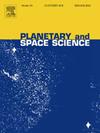两颗偏心和相互倾斜的巨行星的动力机制
IF 1.7
4区 物理与天体物理
Q3 ASTRONOMY & ASTROPHYSICS
引用次数: 0
摘要
我们考虑一个基本的行星系统,由一个类似太阳的恒星,一个类似木星的行星和一个类似海王星的行星组成,在广泛的轨道配置中,不限于分层情况。我们展示了共振图谱,显示了~ 1300个互平均运动共振(MMRs)域及其与混沌和规则动力学的联系。根据长期动力学研究的半解析方法,我们发现了平衡配置的两种制度:一种是低互倾角,平衡与Δϖ在0°或180°附近的振荡有关,另一种是高互倾角,其中平衡由ωi等于90°的整数倍的定义值给出。通过对整个运动方程的数值积分,我们计算了系统在不同构型下的基频,并研究了它们与轨道元的关系。根据基频分析,我们发现了两种依赖于初始相互倾角的动力状态,两种状态之间的极限出现在某个临界倾角30°> ic > 40°处,该临界倾角由长期共振g1=g2的出现所定义。对于i<;ic,动力学类似于低(e,i)的经典长期模型,具有定义良好的三个基频和自由模态和强迫模态,保持相互倾斜度准常数。对于i>;ic,随着相互倾斜度变化的增加和基频组合的出现,动力学完全不同,并且根据情况,由长期共振或vZLK机制主导。本文章由计算机程序翻译,如有差异,请以英文原文为准。

Dynamical regimes of two eccentric and mutually inclined giant planets
We consider a basic planetary system composed by a Sun like star, a Jupiter-like planet and a Neptune-like planet in a wide range of orbital configurations not limited to the hierarchical case. We present atlases of resonances showing the domains of mutual mean-motion resonances (MMRs) and their link to chaotic and regular dynamics. Following a semi-analytical method for the study of the secular dynamics we found two regimes for equilibrium configurations: one for low mutual inclinations were equilibrium is related to oscillations of around or , and other for high mutual inclinations where the equilibrium is given by defined values of the equal to integer multiples of . By numerical integration of the full equations of motion we calculate the fundamental frequencies of the systems in their diverse configurations and study their dependence with the orbital elements. According to the analysis of the fundamental frequencies we found two dynamical regimes depending on the initial mutual inclination and the limit between the two regimes occurs at some critical inclination defined by the occurrence of the secular resonance . For the dynamics is analogue to the classic secular model for low with well defined three fundamental frequencies and free and forced modes, conserving quasi constant the mutual inclination. For the dynamics is completely different with increasing changes in mutual inclination and emerging combinations of the fundamental frequencies and, depending on the case, dominated by the secular resonance or the vZLK mechanism.
求助全文
通过发布文献求助,成功后即可免费获取论文全文。
去求助
来源期刊

Planetary and Space Science
地学天文-天文与天体物理
CiteScore
5.40
自引率
4.20%
发文量
126
审稿时长
15 weeks
期刊介绍:
Planetary and Space Science publishes original articles as well as short communications (letters). Ground-based and space-borne instrumentation and laboratory simulation of solar system processes are included. The following fields of planetary and solar system research are covered:
• Celestial mechanics, including dynamical evolution of the solar system, gravitational captures and resonances, relativistic effects, tracking and dynamics
• Cosmochemistry and origin, including all aspects of the formation and initial physical and chemical evolution of the solar system
• Terrestrial planets and satellites, including the physics of the interiors, geology and morphology of the surfaces, tectonics, mineralogy and dating
• Outer planets and satellites, including formation and evolution, remote sensing at all wavelengths and in situ measurements
• Planetary atmospheres, including formation and evolution, circulation and meteorology, boundary layers, remote sensing and laboratory simulation
• Planetary magnetospheres and ionospheres, including origin of magnetic fields, magnetospheric plasma and radiation belts, and their interaction with the sun, the solar wind and satellites
• Small bodies, dust and rings, including asteroids, comets and zodiacal light and their interaction with the solar radiation and the solar wind
• Exobiology, including origin of life, detection of planetary ecosystems and pre-biological phenomena in the solar system and laboratory simulations
• Extrasolar systems, including the detection and/or the detectability of exoplanets and planetary systems, their formation and evolution, the physical and chemical properties of the exoplanets
• History of planetary and space research
 求助内容:
求助内容: 应助结果提醒方式:
应助结果提醒方式:


